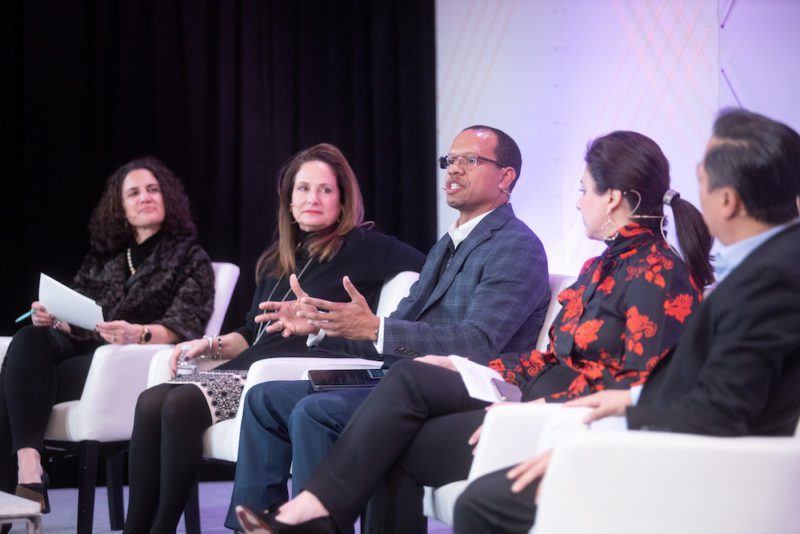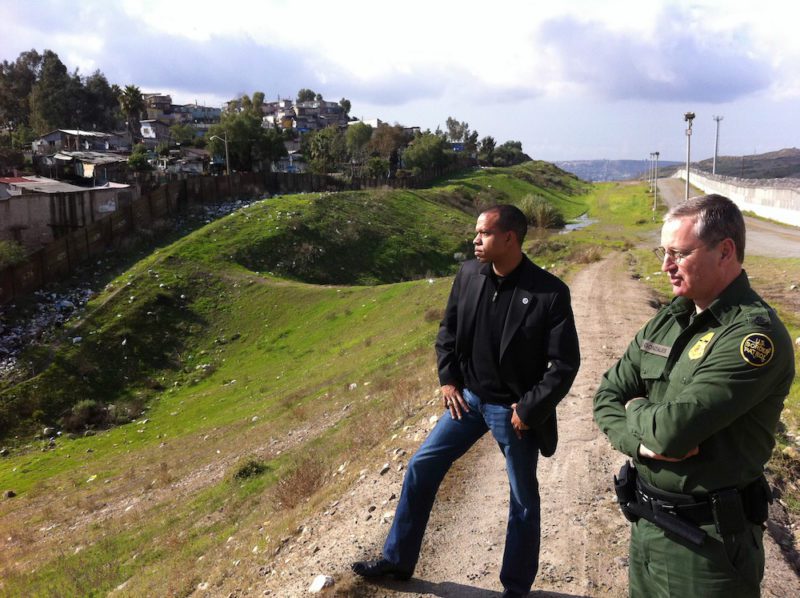
Cedric Sims grew up in rural Texas and spent his formative years on a farm, and though his educational and professional path wasn’t by design, it was his upbringing that led him to his love of computers and a learned value of a day’s work.
A native Houstonian, Sims is a senior leader of Booz Allen Hamilton’s Justice, Homeland Security and Transportation business, where he leverages more than 25 years of experience in areas including acquisitions and risk management, cybersecurity, capital planning, portfolio and program governance, and systems engineering applied to his client’s core missions. He has worked for the U.S. Secret Service, the Department of Homeland Security and led his own company — but not before making eclectic educational choices.
Sims has loved computers since his days driving a Kubota tractor as an adolescent. So, when he got to Texas A&M University, he chose to study computer science in the College of Engineering.
“It gave me all the fundamentals, not just of the programming but also the engineering fundamentals for problem-solving,” Sims said.
And after taking a media ethics class as an elective, Sims decided to combine engineering with liberal arts to produce two degrees: a bachelor’s degree in computer science and one in journalism. He graduated with both in May 1994.
“I really enjoyed the balance of learning about technology along with things that were creative in nature, and so that aspect was something I found very rewarding in my college career,” Sims said.
After completing his undergraduate work, Sims’ departmental chair reached out to encourage him to continue his education.
“The school really had a strong push to try to encourage minorities to continue their postgraduate education, and especially in the College of Engineering, where there are great salaries and great opportunities and underrepresentation,” Sims said.
And at the time, Sims said the number of African-American students graduating and successfully achieving doctorates was low.
“And that’s just the few that actually start the process,” Sims explained.
With the encouragement and advocacy of his departmental chair showing him a path for something he hadn’t even considered, Sims went into a direct-entry 5-year Ph.D. program. After completing his postgraduate coursework, he took a professional and personal detour that entailed work, marriage and children, but ultimately refocused to finish his dissertation and receive his doctorate in engineering from Texas A&M.

Getting Right to Work
Sims’ technical professional career began in college. As an undergrad, he worked in a graphics lab with the first Macintosh computers, primarily putting paper into printers and clearing jams.
“That was my technical prowess at the time,” Sims joked.
Later, he worked full time for the university while enrolled in his doctoral program, and as time went on, he took on increasingly more complex roles. One of them was at an energy conservation lab, putting data instrumentations on state buildings being renovated and retrofitted with things like fluorescent lighting to measure energy savings from upgrading aged infrastructure.
“I did a lot of programming in terms of collecting data from the loggers and performing data analysis. Again, we’re talking early ’90s, so it’s not exactly as robust as what we consider data science today, but I feel like I had my toe in that water back then,” Sims said.
Sims then worked as a research associate for Texas A&M Engineering Experiment Station from 1993-1997, and as a program manager at Texas A&M Transportation Institute from 1997-2000. He also spent time as a consultant at SAE International from 1999-2000, and as a program manager at Texas Center for Applied Technology from 2000-2001.
These early-career opportunities led Sims to a law enforcement modernization project that explored how newly evolving technologies at the time, like Cellular Digital Packet Data, could be used to move data while in motion in an open, nonbuilding-confined space.
It was that project that caught the attention of the U.S. Secret Service. Sims began working there on the White House security and presidential limousine program while still at Texas A&M, which led to a recruitment and full-time opportunity as an operator.
During his time with the Secret Service, Sims was involved with securing public large-scale gatherings designated by the president after Sept. 11, 2001. He also served as a coordinator for several extensive events, including the G8 Summit, which had intricate collaboration requirements among federal, state, local agencies and the visiting delegations.
In his final year and a half with the Secret Service, Sims worked at the director’s office in the Senior Executive Service Candidate Development Program, where a select set of leaders within the service are prepared for senior executive roles.
While the program typically prepares execs for within, Sims helped build the service’s first 5-year strategic plan that included a set of functional requirements and analysis that bolstered and supported a large financial request to DHS.
And even though the Secret Service sits within DHS, Sims said it was the first time the Secret Service had brought forward a resource allocation plan that had analysis, data and architecture behind it. The office of the secretary of homeland security asked Sims to brief the plan, and the department began looking at ways it could get other DHS components to follow suit.
Sims then got the opportunity to join DHS headquarters as executive director of the Office of Program Accountability and Risk Management in 2009.

“For me, it was all about the missions, so working with the operators to make sure those mission plans were accurately conveyed and that we could justify financial and resource requests for the department was paramount,” he said.
Sims was with DHS headquarters until 2012, when he left to run Evermay Consulting Group. The company provided advisory services, strategic capture and proposal management to private industry companies working with government agencies like DHS, the Department of Veterans Affairs and the Federal Aviation Administration.
“The focus was to help those organizations deliver more effectively for the clients that they supported,” Sims explained.
He chose this venture and transition for a few reasons. While he was doing very well at DHS, he saw the opportunity to advise industry on how it could be even more helpful to government agency needs.
“In my role in the government, there was [only]so much that I could do in that regard,” Sims said.
“There was also a balance of saying, ‘Might there be something different that I might want to do in this season?’” Sims explained. “And so, I did that and made the transition out into the private sector, and it was the right decision for me and my family.”
Evermay Consulting Group grew, transformed and expanded its portfolio of capabilities under Sims’ leadership. He served as president and CEO until 2018.
And joining industry after years in government helped Sims see how businesses and different corporations function. But it was the contributions to government and outcomes the government was realizing through Evermay’s work he found most rewarding.
The Phone Call
Sims wasn’t looking for an opportunity when the one to join a consulting firm rang — literally.
“The opportunity to come to Booz Allen Hamilton arose with a somewhat humorous phone call that I received,” he said. “I was offered an opportunity to talk to an unnamed company, and I soundly turned it down.”
But when he received another call a few weeks later, it was a request to at least have a discussion before he said no. So, he did, and met with a number of senior leaders.
“And I have to tell you, I’ve never seen a set of executives that are so committed as I have in my career to the welfare and outcomes of missions — missions that matter — solving really, really hard challenges — and bringing the right people into that equation,” Sims said.
And after a round of discussions with senior leaders, Sims felt like he had found a home.
“I found a really incredible place where I could work alongside leaders that shared my passion,” he said.
Sims joined Booz Allen in 2018, and looking ahead, is excited about the capabilities the company is developing — from machine learning to artificial intelligence — which he calls “truly transformative.”
Motivation Beyond Mission
Sims is motivated and driven in GovCon by mission, having seen first-hand the government exists for the benefit of the citizens it serves.
But he’s also motivated by working with people, seeing their success and helping them realize what they want to achieve personally and professionally. And he’s had the opportunity to watch those he’s mentored reach those goals.
Relatably, being a diverse leader is important to Sims, and he hopes he will encourage other minorities to see the opportunities they have at the firm.
“Being able to represent our very diverse workforce is a great honor here at Booz Allen,” Sims said.
Life of Learning
There are several lessons Sims has learned that have proved valuable — like how to encourage, enable and empower people and be empathetic to truly understand what motivates every person.
But professional experience aside, Sims learned the true meaning of a hard day’s work early on.
During his upbringing, Sims’s dad had bought a tractor to help maintain the large non-operating farm they lived on.
“Like any other teenage kid wanting to have spending money, I would buy the diesel for our tractor and I would go and run the brush hog, which is a wide mowing deck,” Sims said. “And I would spend hours running a brush hog up and down acres and acres of land.”
Sometimes, it was dusty, sometimes it was rainy, and sometimes he’d back the tractor into a tree and knock the muffler off, having to repair it on the spot.
And he’d do all that work for $14, but he was happy for those $14, and it taught him something that stuck with him for life.
“Every day that I work in a place like Booz Allen, I feel very fortunate for the opportunities I’ve had, and I remember those moments,” Sims said.
And at Booz Allen Hamilton, Sims plans to spend the next decade expanding the firm’s work into other parts of the federal government to continue bringing the best impact and best capabilities to clients. That, he said, will be very rewarding.

